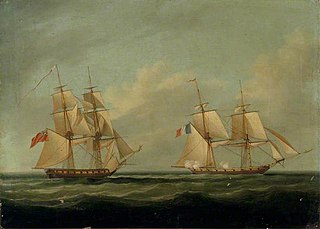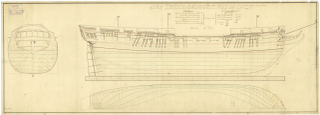
HMS Meteor was a bomb vessel of the Royal Navy. She was previously the West Indiaman Sarah Ann, launched at Newcastle upon Tyne in 1800 that the Admiralty purchased in October 1803. She conducted bombardments at Havre de Grâce, the Dardanelles, and Rosas Bay, on the Spanish coast. She was sold in 1811. she then returned to mercantile service under her original name, Sarah Ann. She continued to trade, primarily across the North Atlantic. She was last listed in 1863 with stale data.

HMS Epervier was a French 16-gun Alcyon-class brig. HMS Egyptienne captured her in the Atlantic Ocean on 27 July 1803; she was taken into Royal Navy service under her existing name. Before being broken up in 1811 she captured several prizes and was present at the Battle of San Domingo. Her crew received a clasp to the Naval General Service Medal for their participation in that battle and another for an action in December 1808. She was laid up in late 1810 and was sold in 1811.

HMS Wasp was an 18-gun sloop of the British Royal Navy. She was formerly the French naval brig Guêpe, which the Navy captured in 1800. She served during the French Revolutionary and Napoleonic Wars, and was sold out of naval service in 1811.

HMS Curieux was a French corvette launched in September 1800 at Saint-Malo to a design by François Pestel, and carrying sixteen 6-pounder guns. She was commissioned under Capitaine de frégate Joseph-Marie-Emmanuel Cordier. The British captured her in 1804 in a cutting-out action at Martinique. In her five-year British career Curieux captured several French privateers and engaged in two notable single-ship actions, also against privateers. In the first she captured Dame Ernouf; in the second, she took heavy casualties in an indecisive action with Revanche. In 1809 Curieux hit a rock; all her crew were saved but they had to set fire to her to prevent her recapture.

HMS Scorpion was a Royal Navy Cruizer-class brig-sloop built by John King at Dover and launched in 1803. She was the first of the class to be built since the launching of Cruizer in 1797. Scorpion had a long and active career during the Napoleonic Wars, earning her crews three clasps to the Naval General Service Medal when the Admiralty authorized it in 1847, two for single-ship actions. She also took a number of prizes. Scorpion was sold in 1819.
HMS Pilchard was a Royal Navy Ballahoo-class schooner of four 12-pounder carronades and a crew of 20. The prime contractor for the vessel was Goodrich & Co., in Bermuda. She was commissioned under Lieutenant Samuel Crew in May 1804, launched in 1805, and completed at Plymouth in 1806. Although Pilchard was often near naval engagements, she seems not to have had to fire her cannons before she was laid up in 1812. Entries in Lloyd's Register indicate that she continued in mercantile trade from at least 1817 until 1833, under a variety of owners and masters, and as far afield as Africa and Valparaiso.

HMS Musquito. was a Royal Navy Cruizer-class brig-sloop built by John Preston at Great Yarmouth and launched in 1804. She was commissioned in October 1804 under Commander Samuel Jackson. She served in the North Sea and the Baltic, and Jackson supervised the first successful rocket attack in Europe at Boulogne in 1806. After the war she served off Africa and captured some slavers. She was broken up in 1822, having been laid up since 1818.

HMS Beagle was an 18-gun Cruizer-class brig-sloop of the Royal Navy. She was launched in 1804, during the Napoleonic Wars. She played a major role in the Battle of the Basque Roads. Beagle was laid up in ordinary in 1813 and sold in 1814.
HMS Elk was a Cruizer-class brig-sloop, built of pine, and launched in 1804. She served on the Jamaica station where she captured a number of privateers. She was broken up in 1812.
During the period of the French Revolutionary and Napoleonic Wars, there were two or three vessels known as His Majesty's hired armed cutter Active that served the British Royal Navy. The reason for the uncertainty in the number is that the size of the vessels raises the possibility that the first and second may have been the same vessel.

HMS Entreprenante was a 10-gun cutter that the Royal Navy captured from the French in 1798. The British commissioned her in 1799 and she served during the French Revolutionary and Napoleonic Wars, participating in the Battle of Trafalgar. She has been the only ship of the Royal Navy to bear the name. She took part in several small engagements, capturing Spanish and French ships before she was sold in 1812 for breaking up.
HMS Firm was a 12-gun Archer-class gun-brig of the Royal Navy, launched on 2 July 1804. She served in the Channel, where she engaged in one action that would eventually result in her crew qualifying for the Naval General Service Medal. She grounded in 1811 and her crew had to destroy her before abandoning her.
HMS Harrier was a Cruizer-class brig-sloop launched in 1804. She took part in several notable actions before she was lost in March 1809, presumed foundered.

The French brig Voltigeur was a Palinure-class brig launched in 1804. The British captured her in 1806 and renamed her HMS Pelican. She was sold in 1812.

HMS Paulina was a British Royal Navy 16-gun brig-sloop of the Seagull class launched in December 1805 for cruising. She had a relatively uneventful career before she was sold in 1816.

HMS Savage was a 16-gun brig-sloop of the Seagull class of the British Royal Navy, launched in July 1805. She served during the Napoleonic Wars and captured a privateer. She grounded in 1814 but was salved. The Navy sold her in 1819.

HMS Moselle was a Cruizer-class brig-sloop of the Royal Navy, launched in 1804. She served during the Napoleonic Wars in the Mediterranean, the Caribbean, and the North American station. She was sold in 1815.

HDMS Friderichssteen or HMS Frederichsteen was a Danish Navy frigate, built in 1800, and captured by the Royal Navy in 1807 at the Battle of Copenhagen. She was taken into service as HMS Fredericksteen and served in the Mediterranean until being finally broken up in 1813.
HMS Cracker was a later Archer-class gun brig, launched in 1804. She participated in several actions and captured two small French privateers. She was sold for breaking up in 1816.

The Thames-class frigate was a 32-gun fifth-rate frigate class of eight ships of the Royal Navy based on the Richmond-class frigate designed by William Bately. The ships were ordered to the older design, which was of a smaller type of ship compared to more modern designs, so that they could be built quickly and cheaply in time to assist in defending against Napoleon's expected invasion of Britain. The class received several design changes to the Richmond class, being built of fir instead of oak, with these changes making the class generally slower and less weatherly than their predecessors, especially when in heavy weather conditions. The first two ships of the class, Pallas and Circe, were ordered on 16 March 1804 with two more ordered on 1 May and the final four on 12 July. The final ship of the class, Medea, was cancelled on 22 October before construction could begin but the other seven ships of the class were commissioned between 1804 and 1806.











